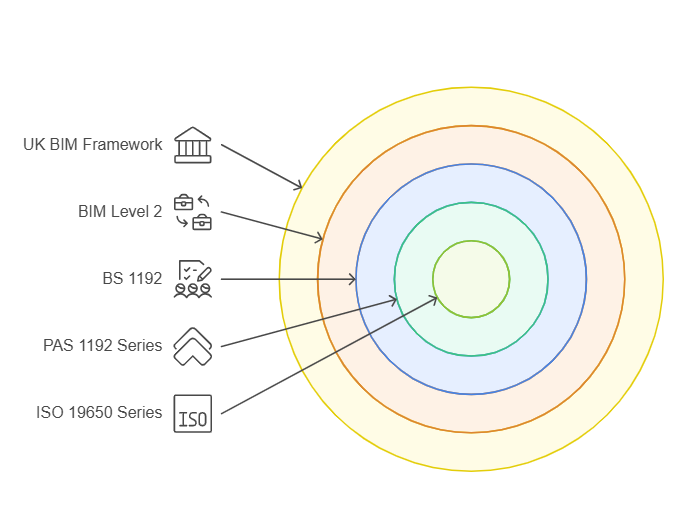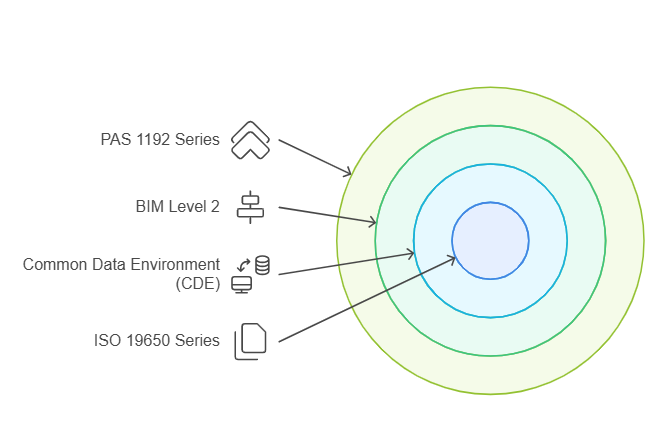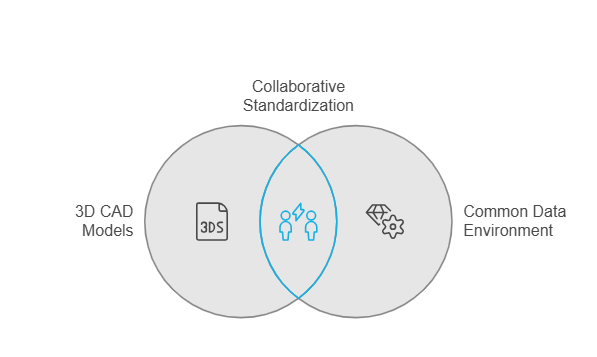A recent report reveals that 73% of construction professionals use BIM, highlighting the industry’s growing reliance on digital tools. This shift underscores how the UK has positioned itself as a global leader in digital construction, leveraging BIM frameworks, standards, and guidelines to transform traditional workflows.
The UK government has established a strong foundation for collaboration, efficiency, and innovation in the built environment by mandating BIM adoption for public-sector projects. As a result, these frameworks have become technical necessities for project success and serve as strategic enablers of progress, fostering smarter decision-making and enhanced project outcomes.
In this article, you’ll learn the BIM standards and guidelines, compliance levels, and resources that drive BIM adoption. You’ll also discover the UK government BIM’s impact on construction and the future trends shaping its role in transforming the built environment. Let’s start.
UK Government’s BIM Standards and Guidelines 2025
In the UK, BIM practices are standardised through frameworks, standards, and guidelines designed to improve teamwork, efficiency, and construction quality.
At the heart of these efforts lies the UK BIM Framework, which provides a clear and consistent approach for effectively implementing BIM across the industry. This framework was developed to meet the government’s Level 2 BIM requirements, which are mandatory for all centrally funded public-sector projects.
The UK BIM Framework is grounded on a set of standards and documents that guide the effective use of BIM. These include:

| Aspects | Standards |
| BS 1192 | A BIM teamwork standard focusing on workflows and data management. |
| PAS 1192 Series | A BIM Level 2 guidelines covering information management and project delivery processes. |
| ISO 19650 Series | An international standard for managing information with BIM. It supports the framework’s goal of organised data sharing and collaboration. |
The BS EN ISO 19650 series stands out among the standards because it introduces a globally recognised framework for managing information throughout a project’s lifecycle. It focuses on collaboration and structured data sharing, which builds upon the UK’s existing BIM practices.
In addition, the BS EN ISO 19650 series ensures consistency across domestic and international projects, making it a critical component of the industry’s digital evolution. It strengthens collaboration and data management and lays the foundation for seamless integration into existing workflows.
Integration of BS EN ISO 19650 Series into Current Practices
The BS EN ISO 19650 series is the globally accepted standard for using BIM and managing information in construction projects. It aligns with the UK government’s BIM Framework and provides a clear method for handling information throughout a project’s lifecycle. BS EN ISO 19650 series include:
| Aspects | BS EN ISO 19650 Series |
| ISO 19650-1 (Concepts and principles) and ISO 19650-2 (Delivery phase) | Guides information management during design, construction, and operation. |
| ISO 19650-3 (Operational phase) | Focuses on managing information after construction is completed. |
| ISO 19650-5 (Security-minded information management) | Deals with keeping information secure during all stages. |
Integrating the ISO 19650 standards into everyday practices is vital for several reasons:
- Consistency and Standardisation:- These standards establish a unified approach for managing information across all project stages, reducing errors, miscommunication, and delays while controlling costs.
- Improved Collaboration:- By ensuring all stakeholders—architects, contractors, consultants, and facility managers—work with the same data and follow consistent methods, these standards enhance teamwork and coordination.
- Better Project Delivery:- Adopting ISO 19650 standards helps projects meet quality objectives, minimise risks, and manage digital assets more efficiently throughout their lifecycle.
- Legal and Regulatory Compliance:- Embracing these standards enables organisations to meet legal and regulatory requirements, particularly for large public-sector projects.
Following ISO 19650 aligns BIM practices with UK rules and international best practices. Exploring the guidance documents, such as Guidance Part 1 and Parts A-F, provides further clarity and support for effective BIM implementation.
Guidance Documents such as Guidance Part 1 and Parts A-F
Guidance Part 1 (BIM Terminology and Overview) introduces BIM principles and explains key terms. It helps all stakeholders develop a shared understanding of BIM concepts.
On the other hand, Guidance Part A-F provides in-depth, topic-specific advice on various BIM aspects. These include strategic planning, project execution, and legal or contractual considerations. Let’s have a look at them:
| Aspects | Guidance Part A-F |
| Part A (Strategy and Organisational Framework) | Helps organisations develop a BIM strategy that supports their goals and meets industry requirements. |
| Part B (Project Information Management) | Focuses on effectively managing project data and ensuring its accuracy, consistency, and timely sharing. |
| Part C (Collaboration and Communications) | Offers practical tips for efficient teamwork and covers protocols for communication, data sharing, and decision-making. |
| Part D (Quality Assurance and Control) | Explains how to maintain quality throughout the project through checks, audits, and control measures. |
| Part E (Risk Management and Security) | Guides organisations in handling risks and protecting sensitive data during the project. |
| Part F (Legal and Contractual Issues) | Addresses legal matters such as contracts, intellectual property, liability, and dispute resolution in BIM projects. |
The UK BIM Framework’s Guidance Parts A-F documents are valuable for both beginners adopting BIM and experienced professionals looking to enhance their practices.
These guidance documents provide a solid foundation for effective BIM implementation, paving the way for a deeper understanding of the Information Management Mandate. This government plan ensures alignment with required standards across all project stakeholders.
Information Management Mandate
In 2021, the Government released a plan called Transforming Infrastructure Performance (TIP): Roadmap to 2030. This plan changed the BIM Mandate to the Information Management Mandate, which is now carried out using the UK BIM Framework. This new mandate applies immediately and will remain in place for the next 10 years as part of the TIP plan.
If you want to comply with the new mandate, three key documents work together. By following them, you can ensure full adherence to the updated requirements. Here’s an overview:
- Transforming Infrastructure Performance: Roadmap to 2030 – Outlining a vision for innovation and improvements in infrastructure delivery, which aims to close the gap between infrastructure and construction, focusing on societal benefits.
- Construction Playbook – Provides key policies and advice on how public projects and programmes should be assessed, procured, and delivered.
- National Infrastructure Strategy – Plans to improve the UK’s infrastructure to help balance regional development, strengthen the Union, and achieve net zero emissions by 2050.
The documents above establish the foundation for modernising infrastructure through BIM standards and guidelines. To ensure these efforts are successfully executed, it’s essential to understand the legal framework that supports and enforces these practices.
What Legislation is Currently in Place for BIM in the UK?
BIM compliance has two key aspects, one for the company and the other for the project. Here’s a closer look:
- For a Company:- It must be capable of delivering projects in line with the UK BIM Framework, which aligns with international standards such as the ISO 19650 series and BS/PAS 1192 standards. Achieving Business Systems Certification is a valuable way to assess this compliance.
- For a Project:- It requires the application of the UK government’s BIM Framework and the Information Management process, as outlined in BS EN ISO 19650-2:2018, throughout the asset delivery phase.
The Information Management Mandate now requires this protocol to be included in contracts. This ensures that all procurement and contractual processes align with the UK BIM Framework standards throughout project delivery.
Embedding the BIM Protocol into contracts ensures consistent adherence to UK BIM Framework standards through the Information Management Mandate. Understanding when to apply BIM to a project is essential for maximising its benefits and ensuring successful implementation.
When should BIM be Used for a Project in the UK?
Public-funded projects are required to follow the UK government’s BIM Framework. This is mandated by the Information Management Mandate in the TIP Roadmap to 2030 and by the Government’s guidelines in the Construction Playbook. The framework applies to all types of projects—roads, railways, buildings, etc.—regardless of size, and it focuses on societal impacts in every decision.
Implementing can address many challenges in projects without public funding, regardless of their scale. However, introducing standards and processes for suppliers, combined with 3D coordination and a data exchange system (the Common Data Environment), ensures reliable information delivery.
The established framework and legislation lay a strong foundation for advancing construction practices. It positions the UK’s BIM standards as a key driver in the global shift towards more efficient and standardised project delivery.
Transition to International Standards
The UK’s adoption of the BS EN ISO 19650 series aligns with global information management practices in BIM, focusing on international compatibility and scalability. Here’s a look at the shift from BIM Level 2 to BS EN ISO 19650:

- BIM Level 2 was UK-specific and based on the PAS 1192 series that defined roles, responsibilities, and processes for information management.
- In contrast, the BS EN ISO 19650 series builds on these principles and aligns them with international standards.
- ISO 19650-1 and ISO 19650-2 provide a standardised approach to managing information during asset delivery and operational stages.
This adoption allows UK firms to follow globally recognised best practices. It boosts their competitiveness on international projects. In addition, it also encourages consistent workflows, reduces the learning curve for global teams, and ensures smoother collaboration.
Facilitation of Collaboration on Global Projects
Adopting international standards like BS EN ISO 19650 has made cross-border collaboration easier by providing a common framework beyond regional practices. Here’s how they enhance collaboration on global projects:
- Global Compatibility:- ISO standards ensure BIM processes and information management are universally understood, enabling teams from different countries to collaborate seamlessly.
- Standardised Processes:- The ISO 19650 series establishes universal workflows for information management, ensuring consistent data exchange, model sharing, and project coordination.
- Enhanced Collaboration Tools:- Cloud-based BIM platforms and Common Data Environments (CDEs) are vital for real-time collaboration. The ISO standards integrate these technologies, promoting their effective use.
In fact, adjusting information requirements is essential for successful collaboration on global projects. This transition ensures all stakeholders can share and access the necessary data seamlessly, promoting efficiency and consistency across borders.
Adaptation to New Information Requirements and Documentation
The shift to international standards has prompted organisations to adjust their information requirements and improve documentation practices. This change ensures that all project data is accurate, accessible, and meets client and regulatory expectations.
The ISO 19650 series formalises key processes for managing information across projects, here’s how:
| Aspects | Key Processes |
| Exchange Information Requirements (EIRs) | Define what information needs to be exchanged, when, and in which format, ensuring all parties clearly understand their information responsibilities. |
| Asset Information Requirements (AIRs) and Project Information Requirements (PIRs) | Extend beyond the delivery phase to focus on the operational phase of assets, ensuring data’s long-term value and usability. |
The ISO 19650 series also emphasises improved documentation in:
| Aspects | Improvements |
| BIM Execution Plans (BEPs) | Outlines how BIM will be implemented and managed throughout the project. |
| Information Delivery Plans (IDPs) | Specifies when and how information will be delivered at various stages. |
| Project Information Models (PIMs) and Asset Information Models (AIMs) | Ensures data integrity is maintained throughout the asset lifecycle and provides a structured approach to managing project and asset information. |
The transition to new standards presents challenges, making investing in training and capacity-building to meet ISO 19650 requirements essential. Despite these challenges, significant opportunities await.
Improved documentation minimises errors and misunderstandings, leading to time and cost savings. Enhanced information management capabilities allow you to handle more complex, data-driven projects, strengthening your competitive advantage.
BIM Levels and Compliance
Building Information Modelling (BIM) levels show how advanced digital collaboration and data management are in construction projects. Each level explains how much technology, teamwork, and standard rules are used in a project’s design, building, and operation stages.
These levels serve as a structured roadmap for progressively adopting BIM, transitioning from basic digital tools to a fully integrated and collaborative digital environment. Implementing BIM levels enables stakeholders to boost efficiency, mitigate risks, and achieve greater accuracy and quality in project delivery.
Here’s a simple overview of the different BIM levels and their requirements.
1. BIM Level 0: No Collaboration, Use of 2D CAD

BIM Level 0 represents the most basic level of digital use in construction. There is no collaboration at this stage, and project information is primarily managed through 2D CAD drawings, often shared on paper or via non-digital methods.
Projects at BIM Level 0 do not align with modern BIM standards and are insufficient for meeting the demands of public sector contracts or complex projects.
Here are the key features of BIM Level 0:
- No shared digital platform or organised data management.
- Information is shared in unorganised formats like PDFs, paper drawings, or emails.
- Each team works separately, without collaboration.
2. BIM Level 1: Limited Collaboration, Some 3D CAD Usage
BIM Level 1 introduces some collaboration and digital tools. It primarily relies on 2D documentation for most project work, with 3D CAD models used occasionally for specific design elements. While basic standardisation is applied, workflows remain largely separate.
BIM Level 1 is suitable for private-sector projects or smaller, simpler developments, but it does not meet the UK Government’s requirements for public-sector contracts.
Here are the key features of BIM Level 1:
- 2D and 3D CAD tools are used but not fully integrated into a collaborative environment.
- Introduction of a Common Data Environment (CDE) for storing and sharing data among stakeholders.
- Standardised document control and naming rules but limited integration between project teams.
3. BIM Level 2: Collaborative, 3D CAD Models Required for Public Contracts

BIM Level 2 involves collaborative work, where stakeholders share 3D CAD models and organise data within a Common Data Environment (CDE). Each discipline manages its own models, which are shared and coordinated to ensure alignment.
BIM Level 2 is mandatory for all UK Government public sector projects, ensuring project teams adhere to standardised information management processes. It is a key component of the UK Government’s BIM Framework and sets the standard for advanced project delivery.
Here are the key features of BIM Level 2:
- Use 3D CAD models for design and analysis to help in clash detection, visualisation, and informed decision-making.
- Each discipline manages its model, but collaboration occurs when these models are combined to create a coordinated view of the project.
- Standardised protocols like the PAS 1192 series ensure consistent information management.
4. BIM Level 3: Full Collaboration with Shared 3D Cloud-Based Model
BIM Level 3 represents the highest level of BIM maturity. At this level, full collaboration happens through a single, shared 3D cloud-based model. All project stakeholders work together on the same model in real time to make information integration smooth across disciplines and project phases.
Although BIM Level 3 isn’t widely required yet, it represents the future of digital construction practices. It follows international standards, such as the BS EN ISO 19650 series, and supports global collaboration on complex projects.
Here are the key features of BIM Level 3:
- A single, fully integrated 3D model hosted on a cloud platform is accessible to all stakeholders in real-time.
- Full integration of project data, including design, construction, and operational information, enables Lifecycle BIM.
- Advanced use of automation, artificial intelligence (AI), and the Internet of Things (IoT) to improve decision-making and asset management.
- Total interoperability and data transparency ensure everyone can access accurate, up-to-date information.
BIM Level 3 is the highest level of digital construction, where all project stages are closely integrated. It uses a cloud-based 3D model that allows everyone involved—architects, engineers, or contractors—to access and update the project in real-time. This ensures that every decision is made using the most up-to-date and accurate information available.
Are you looking for 3ds Max-based solutions?
BIM ASSOCIATES helps your 3D-modeling, texturing, lighting and rendering with high poly, low poly objects, furniture, buildings, gaming facades and landscapes with scenic renders and walkthrough videos.
Understanding BIM levels and ensuring compliance are crucial steps in adopting BIM standards effectively. These levels provide a structured framework for developing, managing, and delivering information throughout the project lifecycle.
Successful Implementation of BIM
Successfully implementing Building Information Modelling (BIM) is crucial for achieving better outcomes in construction projects. It requires a well-organised approach to manage information, enhance collaboration, and streamline processes. The following key elements are essential for successfully adopting and implementing BIM.
1. Clear Definitions for the Information Needed
Clear definitions of information requirements are essential for successful BIM implementation. Specifying Exchange Information Requirements (EIRs), Asset Information Requirements (AIRs), and Project Information Requirements (PIRs) helps define the data needed at each project stage.
Additionally, engaging all stakeholders during the planning phase is crucial for collaboratively defining information requirements. These definitions should be integrated into the BIM Execution Plan (BEP) to create a shared roadmap for effective information management throughout the project.
2. Production of High-Quality Information
The quality of information generated during a project directly impacts its success. Accurate, consistent, and complete data fosters better decision-making and reduces design, construction, and operations errors.
If you want to ensure accuracy and efficiency, employ advanced BIM software and tools like Autodesk Revit, Navisworks, or Bentley Systems. These tools help create precise 3D models and data sets. Additionally, clash detection tools can identify and resolve design conflicts early in the process, minimising costly delays.
Moreover, training and support should be provided to project teams to ensure they have the skills to produce and manage information effectively.
3. Efficient Transfer of Information
Efficient information transfer is crucial for collaboration and timely decision-making. Using a Common Data Environment (CDE) allows stakeholders to share and access real-time data, reducing errors caused by outdated or incomplete information. Interoperable formats like Industry Foundation Classes(IFC) ensure compatibility across different software platforms and enhance team communication.
Regular updates and data synchronisation should be scheduled to guarantee that all stakeholders have access to the latest information. Additionally, implementing automated data transfer systems minimises manual errors and boosts efficiency, ensuring the seamless flow of accurate information throughout the project.
4. Efficiencies and Risk Reduction through Successful BIM Outcomes
Successful BIM implementation drives significant efficiencies and reduces project risks. By enabling better planning, resource optimisation, and improved coordination through tools like 3D modeling and clash detection, BIM helps minimise rework, avoid delays, and lower costs.
BIM also supports proactive risk management by enabling teams to simulate scenarios and spot potential issues early, ensuring smoother workflows and better project outcomes.
Beyond risk mitigation, the successful adoption of BIM profoundly transforms the construction industry, driving productivity, reducing costs, and enhancing the quality of project delivery. Additionally, BIM fosters innovation, empowering the industry to meet evolving demands for greater sustainability, efficiency, and long-term operational value.
Also read: A Guide to Building Information Modelling (BIM) Impact on Modern Construction Industry.
BIM’s Impact on the Construction Industry in the UK
Building Information Modelling (BIM) has greatly changed the UK construction industry by making projects more efficient, productive, and sustainable. Let’s understand how BIM has impacted the UK construction industry.
Reduction in Waste and Errors
A survey shows that BIM reduced errors and omissions by 41%, showcasing its impact on improving construction efficiency. It has significantly reduced waste and errors in construction by enabling better planning, coordination, and clash detection.
Digital models allow teams to identify and resolve design issues before construction begins, minimising costly rework. Furthermore, accurate estimates of materials and resources help prevent overuse, contributing to the industry’s sustainability goals.
Improved Collaboration and Efficiency
According to a survey, BIM improved collaboration with owners or design firms by 35%, highlighting its role in fostering stronger teamwork among project stakeholders. It enhances teamwork among project stakeholders by enabling the sharing of accurate, real-time information through a Common Data Environment (CDE).
This shared platform ensures everyone works with the same data, improving communication and reducing misunderstandings. As a result, better coordination among teams leads to more efficient workflows and smoother project completion.
Enhanced Productivity and Time Savings
A survey shows that BIM reduced reworks by 31%, leading to significant productivity improvements. It enhances construction projects by streamlining workflows and automating repetitive tasks, boosting productivity.
Visualising and simulating the construction process helps reduce delays, improve scheduling, and ensure timely project completion.
Time savings are further improved by consolidating design, construction, and operational data into a single platform, making it easier and faster to access information.
Increased Digital Tool Adoption in Construction
Almost 60% of contractors use BIM to coordinate systems to improve energy performance, showcasing its role in enhancing sustainability and efficiency. It has accelerated the adoption of digital tools in the UK construction industry, driving innovation and modernisation.
Technologies such as cloud-based collaboration platforms, AI-powered analytics, and digital twins are becoming increasingly prevalent.
BIM has transformed the UK construction industry by cutting waste, improving collaboration, boosting productivity, and driving digital change. It has led to more sustainable and efficient construction practices and supports the GREEN EARTH INITIATIVE.

To further support these advancements, the UK Government’s BIM resources provide valuable tools and insights to help organisations implement and comply with BIM standards effectively.
UK Government’s BIM Resources for BIM Guidance
Access to comprehensive resources is key for successfully adopting Building Information Modelling (BIM). The UK offers various materials, primarily through the UK government’s BIM Framework, to support professionals in implementing BIM; let’s take a look:
UK BIM Framework Website
The UK BIM Framework website is a central BIM guidance and standards hub. It offers free resources, including documents and tools, to help users at all levels of BIM maturity.
Regular Updates
The UK government’s BIM Framework resources are regularly updated to match the latest industry standards, practices, and rules. It includes UK-specific advice, like using the BS EN ISO 19650 series, ensuring alignment with national and global best practices.
Links to Useful Additional Resources and References
The site also links to further resources, including technical standards, case studies, and training materials, helping users explore legal issues, data management, and sustainability in BIM.
As the UK continues to lead in BIM adoption, it faces challenges but is poised to seize opportunities that will shape the future of construction and digital transformation.
Challenges and Future Outlook of UK Government’s BIM
Building Information Modelling (BIM) has greatly improved the construction industry, but there are still challenges in adopting and integrating it widely. Recognising these challenges and preparing for future trends are essential to unlock BIM’s potential and ensure its broad use.
Here are the problems and solutions to the challenges in adopting BIM:
| Problems | Solutions |
| Slow uptake in the private sector due to lack of mandates | Offer tax breaks or grants to help the private sector cover initial costs.The Invest To Grow Derbyshire supplies loans between £15,000 and £250,000 to support private businesses across the East Midlands. |
| High initial software, training, and technology costs | Affordable BIM tools and training programs for small and medium-sized businesses (SMEs).Cloud-based BIM solutions provide a more affordable and scalable option. The cloud-based segment held a 62% share of the construction ERP software market due to its scalability, flexibility, and cost-efficiency. |
| Limited resources among small-to-medium-sized businesses (SMEs) | Provide financial support and accessible resources tailored for SMEs.The Smart Concept Fund offers £16,500 at an intervention rate of up to 55% to fund an approved development project. |
| Resistance to change within organisations | Promote the long-term benefits of BIM, such as cost savings and improved efficiency. |
| Lack of digital skills and knowledge about BIM | Implement training programs and workshops to build digital skills and raise awareness about BIM’s advantages.CITB (Construction Industry Training Board) provides grants for construction industry employers who offer training for their workforce. |
Looking ahead, the construction industry is poised for wider BIM adoption, with digital technologies playing an increasingly central role.
You might also like: UK BIM Framework in 2025: Standards, Guidance, & AI Improvements.
Future Trends, Including Wider Adoption and Integration of Digital Technology
The future of BIM is closely tied to its integration with advanced digital technologies like artificial intelligence (AI) and the Internet of Things (IoT). These technologies will enhance BIM’s capabilities, enabling predictive analytics, real-time data tracking, and improved asset management throughout their lifecycle.
BIM adoption is expected to grow as organisations recognise long-term cost savings and efficiency benefits. Government initiatives, global standards like the BS EN ISO 19650 series, and enhanced cloud-based solutions make BIM more accessible for projects of all sizes.
As digital technologies evolve, BIM will become an integral part of more industries, driving more efficient, data-driven workflows in construction and beyond.
Potential for BIM to Become Standard Practice Across Industries
As digital transformation accelerates, BIM is poised to become a standard practice in construction and industries like manufacturing, infrastructure management, and facilities operations.
Integrating BIM into these sectors can enhance collaboration, support data-driven decision-making, and promote sustainability. As clients demand data-driven solutions and regulatory bodies adopt global standards, BIM’s role as a crucial tool for modern project management will continue to grow.
Conclusion
The UK is actively advancing BIM standards, reinforcing its role as a global leader in digital construction. The government ensures consistent and efficient information management across all BIM levels by aligning its BIM Framework with international standards like BS EN ISO 19650.
Mandating BIM Level 2 for public-sector projects has accelerated adoption, fostering local and global integration and collaboration. Through continuous refinement, the UK keeps its BIM practices in line with international benchmarks while addressing the specific needs of its industry.
The UK remains at the forefront of digital transformation by overcoming investment barriers and closing skill gaps. BIM is helping to shape a smarter, more resilient, and sustainable construction industry, setting an example for others worldwide.
Are you looking for BIM solutions?
BIM ASSOCIATES is your one-stop BIM Solution provider for Architecture and Structure. Their solutions help clients with better decision-making, cost-saving, efficient construction planning, and GREEN EARTH initiatives.
FAQs (Frequently Asked Questions)
1. Is BIM mandatory in the UK?
BIM Level 2 compliance is required for government projects centrally procured in the UK, with detailed guidelines provided by the UK BIM Framework.
2. When did BIM start in the UK?
The UK government released its BIM strategy in June 2011. It announced that by 2016, it would require collaborative 3D BIM on its projects.
3. What is the UK BIM alliance?
The UK BIM Alliance was established in 2016 as a cross-industry group to encourage the adoption of BIM throughout the UK’s built environment. It was also established to support the wider digital transformation.

